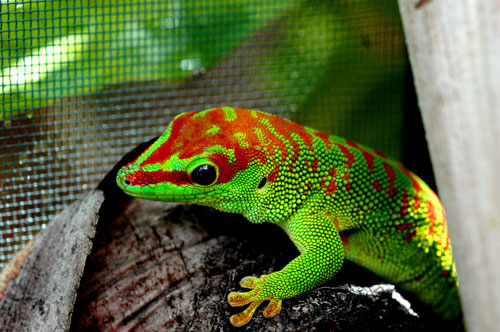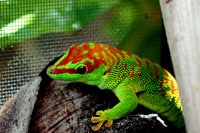Bonus content from the April 2012 REPTILES magazine article "A Celebrity Lizard Exposed."
Lizard enthusiasts often refer to geckos of the Phelsuma genus as jewels of the Indian Ocean islands, and for good reason. Most of them boast vibrant shades of red, blue and green, and they are visually stunning. Unfortunately, not many of the 43 species and 20 subspecies of Phelsuma are available to the reptile trade. This is due to the elevation of the majority of the genus to a more protected status and the banning of their exportation as a means to save wild populations from exploitation and extinction. This act of conservation legislation is vital to their survival and hopefully will encourage more aggressive captive-breeding efforts among reptile enthusiasts.

Jon Klarsfeld
Cherry-headed giant day gecko morph (Phelsuma grandis).
Because the Phelsuma genus is so large, many gecko experts group them according to their size and refer to them as the small, medium and large Phelsuma.
Of the small species, four are commonly available. These include the gold dust day gecko (Phelsuma laticauda), the lined day gecko (Phelsuma lineate), the four-spot day gecko (Phelsuma quadriocellata) and the dull day gecko (Phelsuma dubia). The members of this group range from 4 to 6 inches in total length. Each of these diminutive species has slightly different husbandry requirements, but all should be housed in a vertically orientated, tropical terrarium. Due to their size, they require small food items; otherwise, they are all considered easy to keep.
Of the medium-sized Phelsuma, the Seychelles day gecko (Phelsuma sundbergi) is becoming increasingly available as a captive-bred individual. It reaches a total length of just under 8 inches. In the wild, the females of this species are known to be colony nesters, and more than 50 eggs can be found at one location. They are also known as a highly adaptable species that thrive in captivity and are easy to reproduce.
Lastly, Standing’s day gecko (Phelsuma standingi) is another commonly available species. Similar to the giant day gecko (Phelsuma grandis), it is a large and robust species, reaching a total length of about 9 to 10 inches. As far as habitat, P. standingi prefer a dryer vivarium than P. grandis, and they usually require a seasonal temperature fluctuation to initiate breeding. Standing's day gecko Phelsuma standingi is native to the dry succulent woodlands and deciduous forests in southwest Madagascar. This area is, unfortunately, suffering from rapid deforestation due to coal production. If the current rate of deforestation in southwest Madagascar continues, P. standingi extinction from the wild is imminent. Fortunately, P. standingi is a captive-breeding success story. Due to the dedicated breeders of this species, captive populations of P. standingi are stable and able to meet the demand from the reptile trade.
With future advances in herpetoculture, other Phelsuma species will hopefully become increasingly available to the public. Who knows? Maybe a second Phelsuma will one day reach celebrity status and acquire his own star next to that of the Geico Gecko on the Hollywood Walk of Fame.
Jon Klarsfeld, DVM, practices veterinary medicine in South Florida and owns daygeckos.com, an outdoor breeding and research facility specializing exclusively in Phelsuma grandis. It is dedicated to the advancement, reproduction, protection and biomedical importance of this species. Dr. Klarsfeld currently consults with a pharmaceutical company to develop a drug of human importance derived from his study of P. grandis. If interested in other topics related to giant day geckos, please read some of Dr. Klarsfeld’s other articles at daygeckos.com/studies.html.


